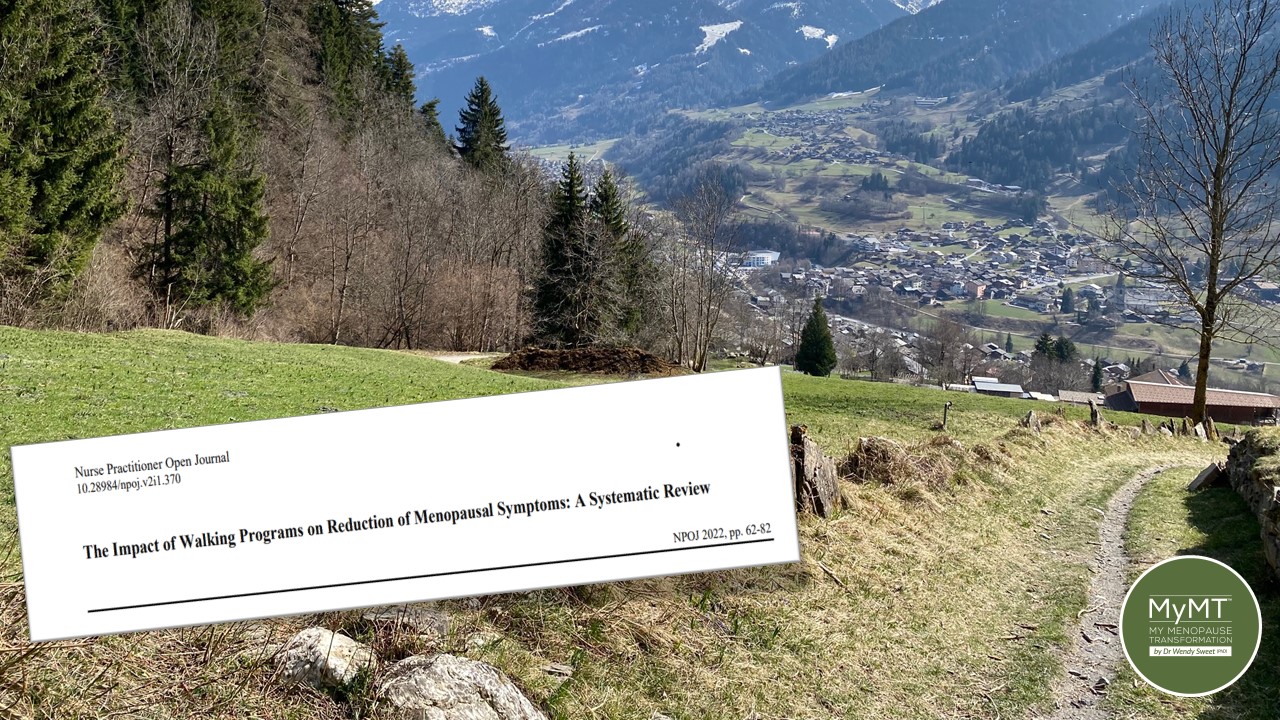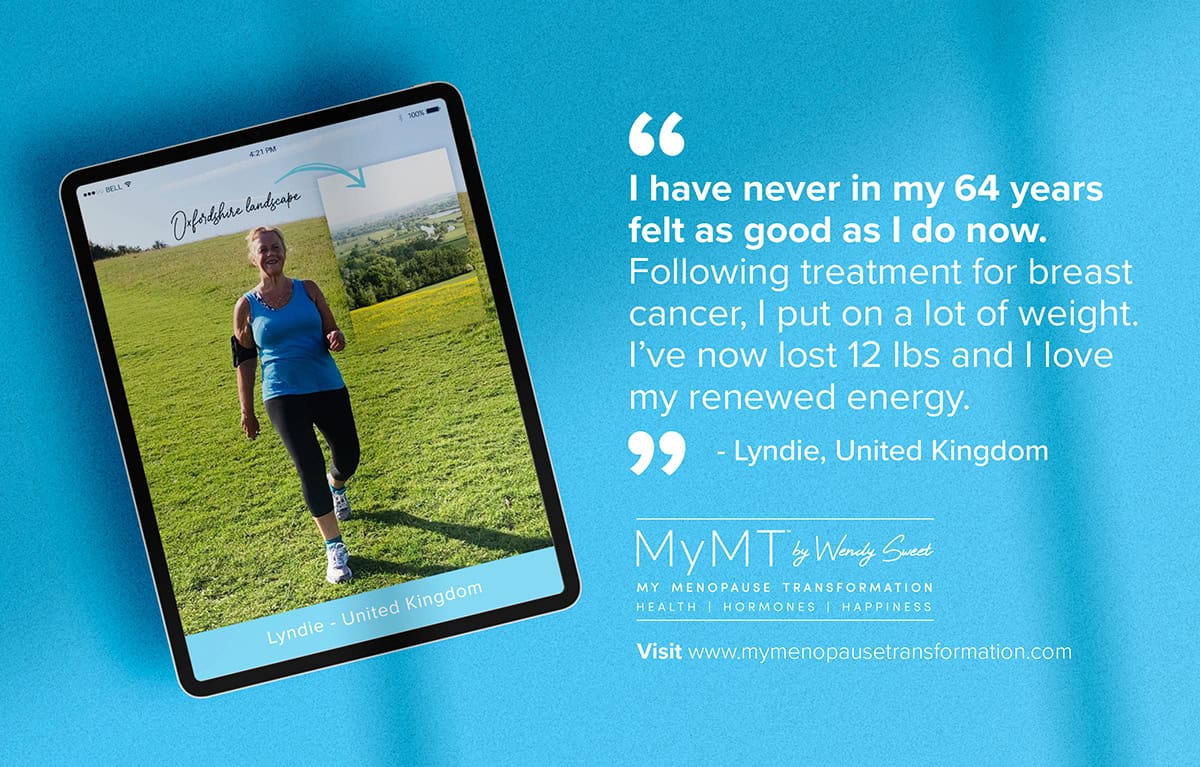Our late Queen Elizabeth II was a great walker. I know this because the internet is full of images of her out walking when in residence at Balmoral Estate in Scotland. Walking with her beloved corgis. Walking her horses. Walking with her late husband and/or, her children. I love how she always wore a beautiful scarf over her hair.
Out of all the images and videos and memories that have been shared over the past week since her passing, it is the images of her looking so free and happy whilst out walking in Scotland that resonated with me.
I like to think that being out in the fresh air striding out around the hills, helped her to cope with all that was going on in her life and of course, around it. According to the Royal biographer, Ingrid Seward, walking helped the Queen to stay fit for her royal duties. That doesn’t surprise me at all.
Walking was the topic of a new study that has been recently released by the Nurse Practitioner Journal (Amanzai, Sidani et al, 2022). The study authors undertook a systematic review of articles published over the past decade in order to identify studies that evaluated walking programmes specifically designed to measure the occurence of menopausal symptoms in midlife women.
Even if sore joints or menopause weight gain are impacting your ability to walk far, I wanted to share it with you.
Amongst all of the walking programmes from pedometer-based programmes to Nordic walking to a Korean walking programme that I have never heard of called SaBang Dolgi, they all had their benefits – especially for menopause-related depression.
The SaBang Dolgi programme is a traditional Korean exercise, whereby participants repeat the movements, beginning while watching the front, and walking around in the same place in four directions— east, west, south and north —and maintaining their energy and centre of gravity in the centre of the body using rotation and directionality. The purpose is to achieve emotional stability. I didn’t know this but judging from the images from the studies findings, it looks fun as well.
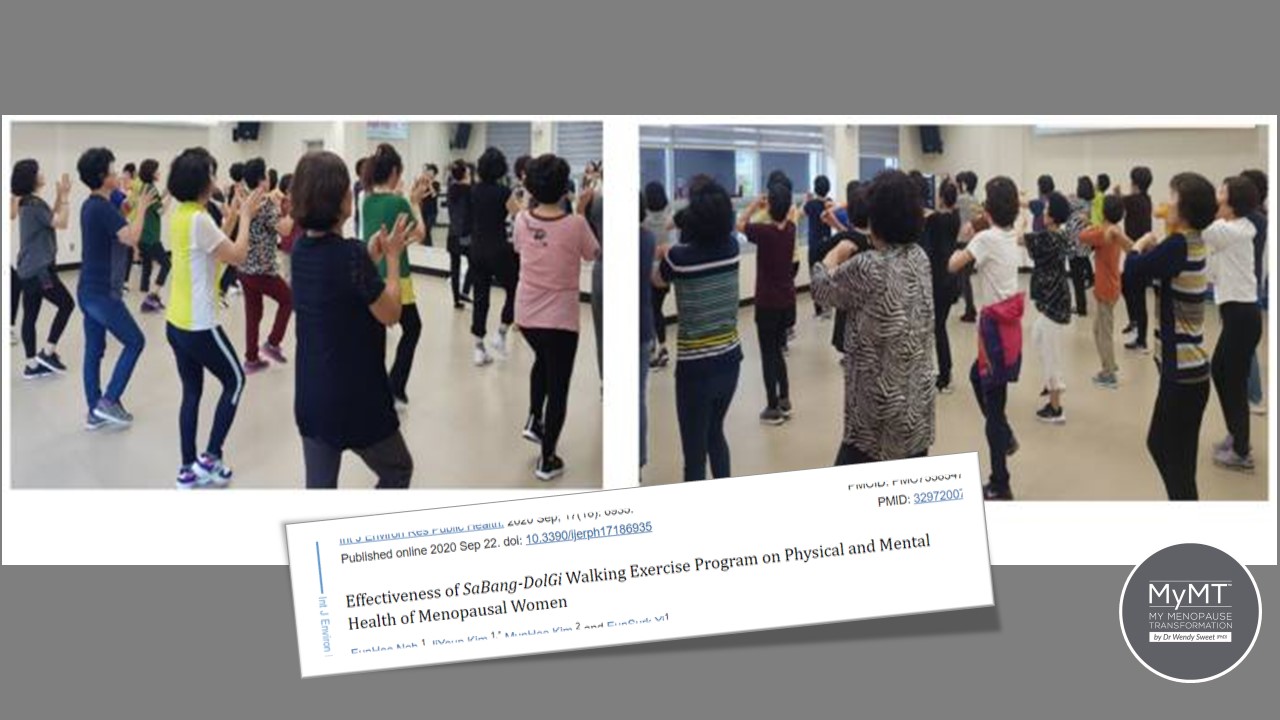
In the walking review, there were a number of different walking interventions. Pedometer-based walking (10,000 steps), Nordic walking (with poles) three times weekly, specific walking training which increased in intensity over 12 weeks and SaBang-Dolgi training, the Korean based movement described above, whereby participants attended three sessions a week for 60 minutes per session.
For those of you who are either sedentary, or are at the other end of the exercise-spectrum and doing a lot of high-intensity exercise in the gym, and/or you are experiencing depressive symptoms, insomnia and hot flushes, the results are worth noting.
Whilst all of the interventions reported changes in menopause symptoms, within the review by Amanzai, Sidani et al, (2022), pedometer-based walking presented the greatest improvement in symptom outcomes. But if you don’t have a preference for counting steps, then just remember that all of the types of walking interventions, including Nordic walking and walking freely without poles or pedometers, reported improvement in post-intervention menopausal symptoms of:
- depression, which saw the greatest reduction post interventions.
- sleep quality and
- physiological markers such as improved blood vessel dilation.
As the study authors noted;
“Menopausal vasomotor and cognitive symptoms can have an impact on quality of life and employment productivity ultimately resulting in financial losses. While hormone replacement therapy is cited as an alleviator of symptoms, its risks encourage the pursuit of alternative lifestyle modifications such as performing exercise. The benefits of exercise include improvements in stress relief, joint pain, reduce cardiovascular risk, cognitive functioning, sleeping patterns, and overall quality of life.” [Amanzai et al, 2022, p. 64]
In this fast-paced world, I call walking for exercise, ‘the forgotten factor in women’s health as they age’. That’s why, in my 12 week MyMT™ programmes, I have designed a 6 week walking programme – numerous women tell me that they print it out and post it to their fridge as their reminder to take action as you can see from the image below of some comments made in my private coaching community when Michelle shared photos of her lunch-time walk in London. The MyMT™ Coaching Community was enthused.
“I feel so proud to work in an amazing City that I wanted to show you what I see if I make the effort to walk. Walking along the River Thames keeps you cool. Is anyone else walking of a lunchtime who would like to share their walk?”
What unfolded was amazing. So many women sharing their walk with us all. Leann was in the Northern Territory in a place called Kings Canyon. Karen was walking at the bottom of the earth in Invercargill, New Zealand. Natalie shared a photo from her walk along the waterfront in Petone, New Zealand. I shared a photo from my walk in Wanaka, and on a balmy day in Sydney, Donna shared the glorious blue sky and city landscape that was Sydney in winter. We even had one of the Canadian ladies share a photo of a Moose, which she saw on her walk.
Many of the women also say that they go walking with a friend and this keeps them motivated too. I love hearing this. Walking and talking is good for women’s cardiovascular health in menopause and support from others is a great way to improve one of my 7 dimensions of women’s health, which is social connection. Furthermore, at a time of our lives when we are busy, it allows us time to ‘think’.
‘Walking allows us to be in our bodies and in the world without being made busy by them. It leaves us free to think without being wholly lost in our thoughts. When we live our lives in cars and buildings and gyms, shopping malls and offices are we are constantly in ‘catch-up’ mode with all that is going on in our lives, in this respect, walking is a detour – a scenic route through a half-abandoned landscape of ideas and experiences.’ (Solnit, 2000).
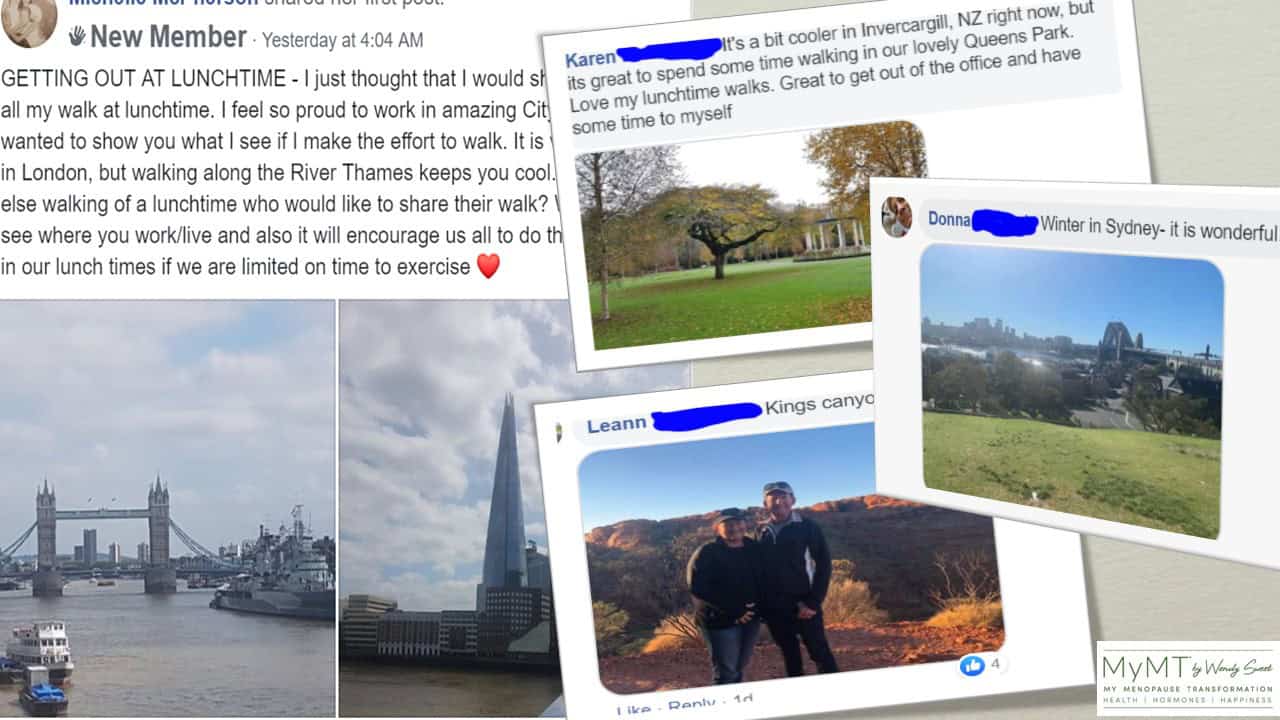
Menopause is a naturally occurring phenomenon for women, but as I mention in my online Masterclass on Menopause webinar (which you can read about HERE), for numerous women, this stage of life presents with several physical and mental symptoms that are more severely experienced.
These experiences can be very distressing for women to deal with, especially because of their personal, social, and work lives mentions Sydora et al (2020) in another scoping review exploring the impact of walking on menopause symptoms.
With known barriers to maintaining physical activity in midlife including, sore joints, poor health, lack of time due to family responsibilities, lack of motivation or inadequate access to facilities and fear of safety, walking offers a great way to get started … as long as you don’t have sore joints, plantar fasciitis or other medical conditions that prevent this.
Walking at lunchtime during your busy day is a great starting point too. It can slow down your thinking and sooth your nerves! As we move through menopause, our nervous system is also experiencing the effects of our ageing, as we not only lose oestrogen on receptors along the nerve sheath, but because our blood vessels lose their elasticity too, this causes an elevation of heart rate and feelings of anxiety and exhaustion and/or irritability.
This is why walking or other aerobic activity during the day helps. Aerobic activity is the type of activity whereby we breathe rhythmically and don’t get too out of breath. The rhythmic movement of aerobic activity helps the nervous system to fire more regularly, thus decreasing feelings of anxiety.
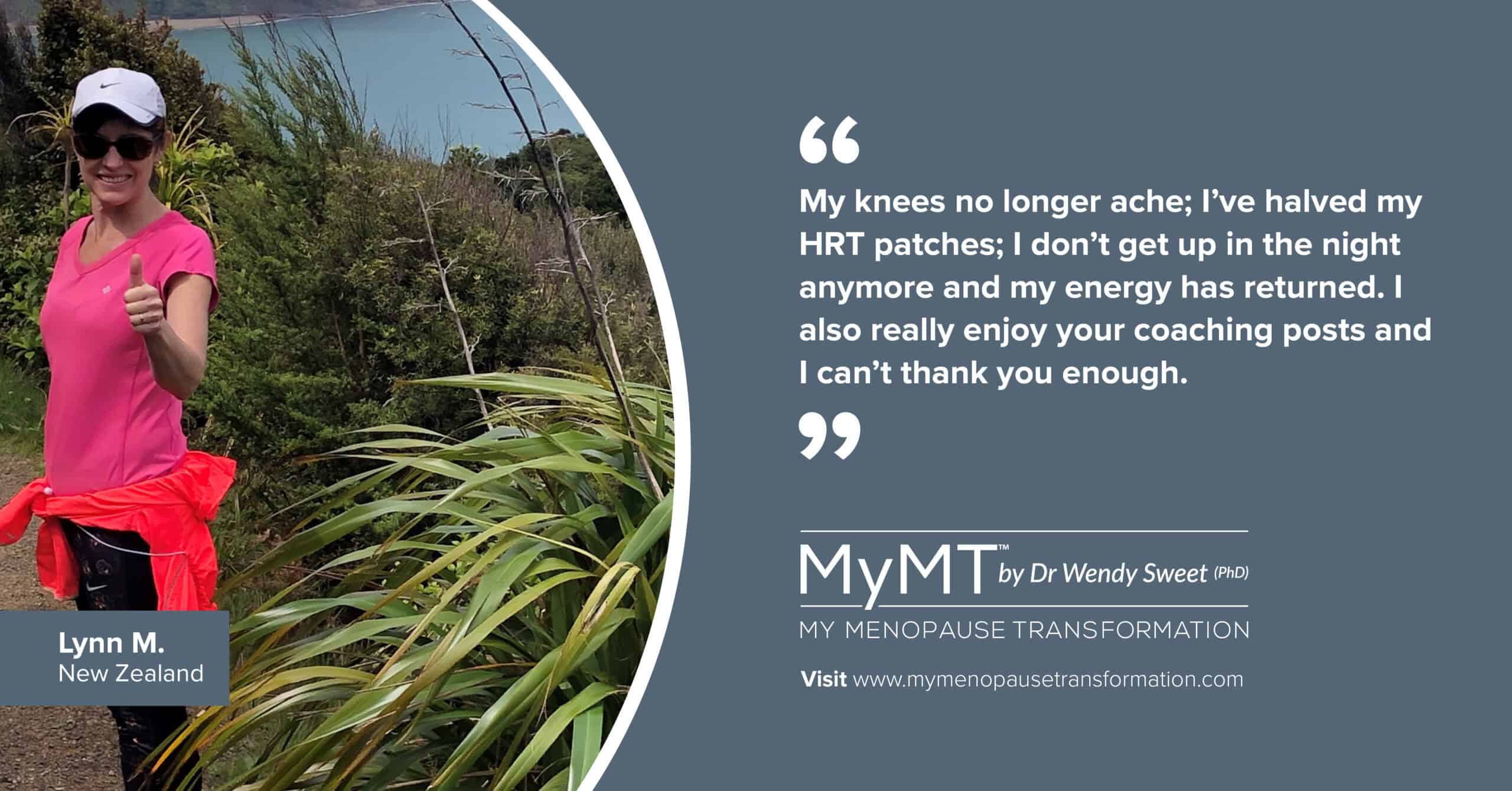
How Much is ‘Enough’ Walking?
When it comes to understanding walking, there is no-one more expert in this subject than Professor I-Min Lee. She has been studying physical activity for decades. As an Associate Epidemiologist at Brigham and Women’s Hospital and a Professor of Medicine at Harvard Medical School, she decided to explore the basis for 10,000 steps and whether this was a realistic target for older women to be achieving.
She and her research team decided to explore the popular premise whether 10,000 steps a day provides a dose-response relationship for the health of post-menopause women. I’m pleased she did.
A goal of 10,000 steps a day is the ‘gold standard’ for millions of people. Over the past decade or so, this benchmark has also sold a huge number of step-counting devices as well as inspired team challenges throughout companies the world over.
These are known as ‘wearable technologies’ and over 125 million units were shipped worldwide when this technology first arrived in 2017. That’s a lot of step-counting. And whilst the 10,000 step phenomenon arrived off the back of a marketing campaign to get more Japanese people walking, it’s still an important goal to achieve, especially for women who are time-poor and struggling with changing cardiovascular health in mid-life.
However, for busy women transitioning through menopause and into post-menopause, 10,000 steps is a challenging number to achieve every day, especially when joints and muscles often become sore and aching. I was the same, hence turning around joint health is important and it’s why I designed you a fabulous joint health webinar – this is in all my foundation 12 week programme, including the Circuit Breaker programme which is on sale throughout the month of September for thinner/ leaner women. The promo code to get NZ$100 off is HERE for you and the video about this powerful Circuit Breaker programme is below.
If you are overweight however and symptoms are bothering you, then explore my Transform Me weight loss programme instead. Alternatively, if you want to learn more about menopause, then just start with my 2 hr webinar called the Masterclass on Menopause. It has lots of great solutions in it for you too.
Physical activity participation research continues to show a decline in physical activity for women over the age of 50 years who are the highest cohort (along with adolescence girls) to drop out of regular physical activity. With our exhaustion and being time-poor, I’m not surprised.
Professor Wendy Brown and her team have been studying this for over 30 years in Australia. And here’s the thing – I can attest to this as well. When I wasn’t sleeping and had sore joints and muscles, felt dizzy and my weight was increasing daily, the last thing I felt like doing was my beloved exercise – especially with the emphasis on boot camps, high intensity workouts and a ‘go-hard, or go-home’ training mantra.
I wish I had known about Professor Min-Lee’s work at the time and her findings which you can read about beneath the video.
Where did the 10,000 steps goal and pedometer-based counting originate?
The 10,000 steps protocol originated back in 1965 when a Japanese company made a device called Manpo-kei. The translated to ’10,000 steps meter’ and it was intended as a marketing tool. So began the notion of needing to achieve 10,000 steps in our health consciousness.
Because Professor Min-Lee had already been studying the relationship between physical activity and health in older women, she took her 10,000 steps curiosity to the midlife women demographic too. I’m so pleased that she did. The research looked at over 16,000 women aged between 62 years to 101 years and for 4 years between 2011 and 2015, all participants wore tracking devices during waking hours.
The researchers wanted to explore whether increased steps were associated with fewer deaths. The findings from the study are important for us all to know – especially for those women struggling to find the time, energy and motivation to exercise. The key findings from the study include:
- Sedentary women averaged 2,700 steps a day.
- Women who averaged 4,400 daily steps had a 41% reduction in mortality.
- Mortality rates progressively improved before leveling off at approximately 7,500 steps per day.
As the researchers concluded, if you want to prevent an early death, then walking matters, and some is better than none. But if you are pushed for time and motivation, then this study suggests you can reap benefits from 7,500 steps a day. That’s 25% fewer steps than the more common goal of 10,000 steps.
“Every step counts” says Professor Min-Lee, “but don’t be intimidated by having to get 10,000 steps if you are a woman in menopause or post-menopause.”
I often share these pointers with women on my coaching programme. If you’re typically sedentary then you are probably doing around 2000 steps daily just in your day to day movement, so try to add 2,000 more daily steps. this will give you an average of at least 4,400 daily steps. While 2,000 steps equals one mile (2.2km), it’s not necessary to walk it all at once. Instead, try to take extra steps over the course of each waking hour.
This is great advice for all of us.
Dr Wendy Sweet, PhD/ Women’s Healthy Ageing Researcher & MyMT™Founder & Coach.
References:
Amanzai, H., Sidani, S., Munro, K., Nadeem W., Ansari, H., Zia, T. & Guruge, S. (2022). The Impact of Walking Programs on Reduction of Menopausal Symptoms: A Systematic Review. Nurse Practitioner Open Journal, 62-82. 10.28984/npoj.v2i1.370
Brown WJ, Mishra G, Lee C, Bauman A. (2000). Leisure time physical activity in Australian women: relationship with well being and symptoms. Res Q Exerc Sport. 2000 Sep;71(3):206-16.
I-Min Lee, Shiroma, E.,Masamitsu K. et.al, (2019). Association of Step Volume and Intensity With All-Cause Mortality in Older Women. JAMA Intern Med. Published online May 29, 2019.
Noh E, Kim J, Kim M, Yi E. Effectiveness of SaBang-DolGi Walking Exercise Program on Physical and Mental Health of Menopausal Women. Int J Environ Res Public Health. 2020 Sep 22;17(18):6935.
Solnit, R. (2001). Wanderlust: A history of walking. Penguin Books.
Sydora, B.C., Alvadj, T., Malley, A. et al. (2020). Walking together: women with the severe symptoms of menopause propose a platform for a walking program; outcome from focus groups. BMC Women’s Health 20, 165, 1-4. https://doi.org/10.1186/s12905-020-01037-y
